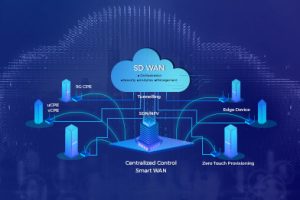Imagine a network that not only delivers ultra-fast speeds but also predicts congestion, prioritizes critical applications, and adapts in real time. That’s the new reality with the combination of Wi-Fi 7 and Artificial Intelligence (AI). As bandwidth-heavy applications like 8K streaming, AR/VR, and real-time collaboration become mainstream, networks must go beyond speed, they need intelligence.
Wi-Fi 7 brings major upgrades in throughput, latency, and spectral efficiency. But when enhanced with AI, it unlocks dynamic capabilities like smart traffic classification, adaptive interference management, and real-time optimization. Together, they form the foundation for next-gen networks that are not just faster—but smarter and self-optimizing.
Table of Contents
Understanding Wi-Fi 7: A Leap in Wireless Performance
Wi-Fi 7 builds on the capabilities of Wi-Fi 6/6E and adds several key enhancements that dramatically increase throughput, reduce latency, and improve efficiency across dense device environments.
Key features of Wi-Fi 7:
- 320 MHz Channels: Doubling the channel width compared to Wi-Fi 6, enabling significantly higher data rates.
- Multi-Link Operation (MLO): Allows devices to connect over multiple frequency bands (2.4 GHz, 5 GHz, and 6 GHz) simultaneously for improved reliability and throughput.
- 4K QAM (Quadrature Amplitude Modulation): Increases data-carrying efficiency by transmitting more bits per symbol, offering up to 20% throughput gain over Wi-Fi 6’s 1024-QAM.
- Enhanced OFDMA and MU-MIMO: Optimized for higher-density deployments with more users and devices.
- Lower Latency: Ideal for time-sensitive applications such as online gaming, video conferencing, and AR/VR.
While Wi-Fi 7 lays the physical and protocol groundwork, the complexity of modern networks still requires adaptive intelligence to manage traffic, mitigate congestion, and maintain optimal performance; this is where AI comes in.
AI in Networking: Beyond Automation to Real-Time Optimization
AI in networking refers to systems that continuously learn from network data to make decisions autonomously. With the rise of edge computing and cloud-managed networks, AI can be implemented directly at the access point or through centralized controllers to deliver intelligent, real-time responses.
How AI enhances networking:
- Pattern Recognition: Learns from historical and real-time traffic data to detect anomalies, congestion, and usage trends.
- Predictive Management: Anticipates traffic spikes or interference and proactively adjusts the network.
- Self-Optimization: Automatically tunes radio parameters, reroutes traffic, and allocates resources without manual intervention.
- Context-Aware Prioritization: Goes beyond basic QoS to prioritize based on application behavior, user intent, and environmental conditions.
These capabilities are particularly valuable in enterprise and service provider networks, where traffic dynamics change minute by minute and user experience is paramount.
Why Wi-Fi 7 and AI Make a Powerful Combination
Integrating AI into Wi-Fi 7 infrastructure transforms traditional static networks into intelligent systems that adapt to their environment. Here’s how this combination is revolutionizing network operations:
1. Advanced Traffic Classification
Legacy QoS mechanisms like DSCP and 802.11e offer basic traffic differentiation but are static and limited. AI-based traffic classifiers in Wi-Fi 7 analyze temporal signatures of traffic flows (e.g., real-time voice, gaming, video streaming) without relying on Deep Packet Inspection (DPI). This approach is:
- Encryption Agnostic: Works even with encrypted traffic
- More Scalable: Models can be updated for new application types
- Cost-Effective: No need for compute-heavy DPI engines
2. Smart Spectrum Allocation
Wi-Fi 7 introduces expanded spectrum in the 6 GHz band and wider channels, but effective use of that spectrum requires intelligence. AI helps select the cleanest and most efficient channel dynamically based on real-time RF conditions, user demand, and interference sources.
3. Intelligent Multi-Link Operation
Multi-Link Operation (MLO) in Wi-Fi 7 enables simultaneous use of multiple frequency bands. AI determines the best band combination for each session, optimizing for latency, throughput, or reliability depending on the application and network conditions.
4. Automated RRM (Radio Resource Management)
AI continuously fine-tunes parameters like transmit power, channel width, and antenna selection. It also performs intelligent band steering and client load balancing. This ensures stable connections, especially in high-density environments.
5. Enhanced Roaming and Client Steering
As users move between access points, AI can anticipate device movement and pre-authenticate clients or shift them to the most optimal AP. This results in seamless handoffs without dropouts—critical for voice and video applications.
Key Use Cases Where Wi-Fi 7 + AI Drive Value
The real-world applications of AI-powered Wi-Fi 7 are extensive:
- 8K Video Streaming: AI-driven traffic shaping and 4K QAM modulation ensure consistent throughput and zero-buffering experiences.
- Remote Work and Collaboration: Prioritized video conferencing and VoIP, even in congested home or office networks.
- Smart Homes and Buildings: AI adapts to device behavior and optimizes AP placement and performance over time.
- Industrial IoT: Predictive analytics and automated interference mitigation increase reliability in mission-critical environments.
- Public Wi-Fi: AI balances large user volumes, ensures fair access, and mitigates rogue access points or interference.
Why OEMs, ISPs, Telcos and Operators Should Invest in AI-Powered Wi-Fi 7
Organizations looking to stay competitive in the wireless space must deliver more than just fast connectivity. The market demands smart, self-optimizing, and scalable networks.
AI-powered Wi-Fi 7 solutions offer:
- Reduced operational overhead through automation
- Fewer support issues due to proactive optimization
- Enhanced user satisfaction and network stability
- Competitive differentiation in a crowded product landscape
VVDN’s Expertise in AI-Powered Wi-Fi 7 Solutions
VVDN offers end-to-end design, development, and manufacturing of AI-powered Wi-Fi 7 Access Points. We support OEMs, Telcos, ISPs, and Operators with custom reference designs, product customization, and white-label solutions to meet their specific needs. From hardware design to mechanical engineering, software development, field testing, and mass production, VVDN helps accelerate time-to-market with scalable, production-ready platforms.
Whether you’re an OEM, ISP, Telco, or Operator, VVDN can help bring your AI-powered Wi-Fi 7 products to market faster. Reach us at info@vvdntech.com
































